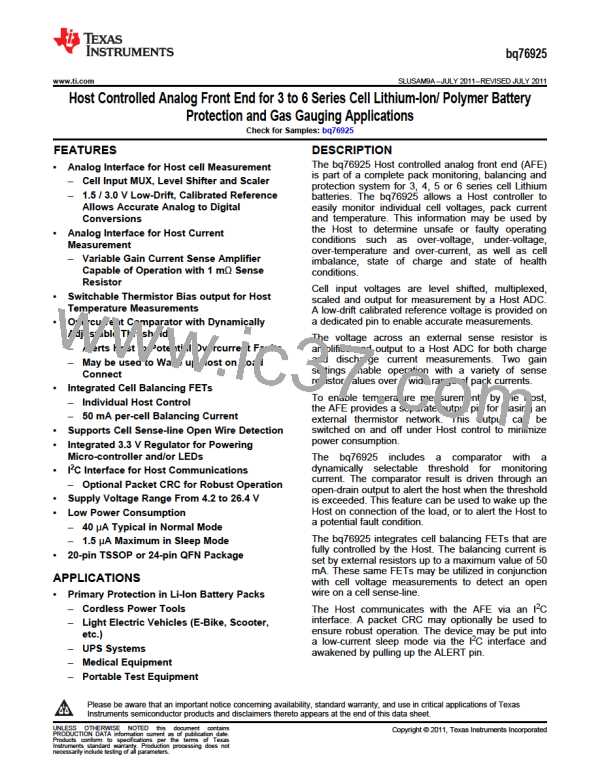bq76925
SLUSAM9A –JULY 2011–REVISED JULY 2011
www.ti.com
Bus Write Command to bq76925
The Host writes to the registers of the bq76925 as shown in Figure 7. The bq76925 acknowledges each received
byte by pulling the SDA line low during the acknowledge period.
The Host may optionally send a CRC after the Data byte as shown. The CRC for write commands is enabled by
writing the CRC_EN bit in the CONFIG_2 register. If the CRC is not used, then the Host generates the Stop
condition immediately after the bq76925 acknowledges receipt of the Data byte.
When the CRC is disabled, the bq76925 will act on the command on the first rising edge of SCL following the
ACK of the Data byte. This occurs as part of the normal bus setup prior to a Stop. If a CRC byte is sent while the
CRC is disabled, the first rising edge of the SCL following the ACK will be the clocking of the first bit of the CRC.
The bq76925 does not distinguish these two cases. In both cases, the command will complete normally, and in
the latter case the CRC will be ignored.
SCL
...
...
...
R/W ACK
ACK
ACK
C0
A6 A5
A0
D7 D6
D0
C7 C6
SDA
CRC
(optional)
Start
Address
Stop
Data
Figure 7. I2C Write Command
Bus Read Command from bq76925
The Host reads from the registers of the bq76925 as shown in Figure 8. This protocol is similar to the write
protocol, except that the slave now drives data back to the Host. The bq76925 acknowledges each received byte
by pulling the SDA line low during the acknowledge period. When the bq76925 sends data back to the Host, the
Host drives the acknowledge.
The Host may optionally request a CRC byte following the Data byte as shown. The CRC for read commands is
always enabled, but not required. If the CRC is not used, then the Host simply NACK’s the Data byte and then
generates the Stop condition.
SCL
...
...
...
C0
NACK
R/W ACK
ACK
A6 A5
A0
D7 D6
D0
C7 C6
SDA
Slave
Drives Data
Slave
Drives CRC
(optional)
Start
Address
Stop
Master
Drives NACK
Figure 8. I2C Read Command
18
Copyright © 2011, Texas Instruments Incorporated

 TI [ TEXAS INSTRUMENTS ]
TI [ TEXAS INSTRUMENTS ]